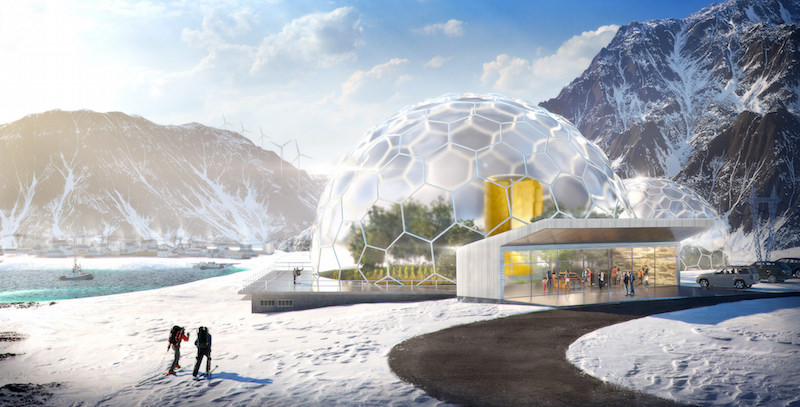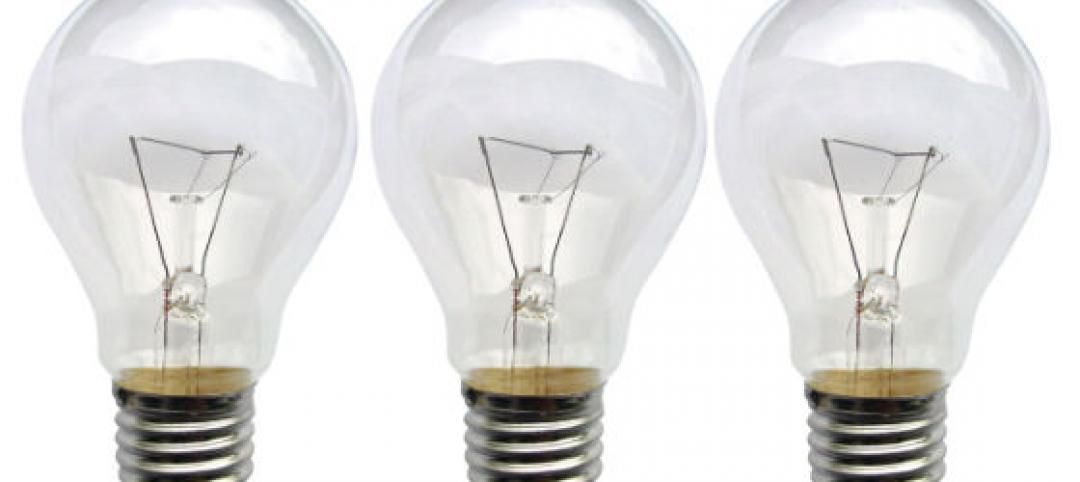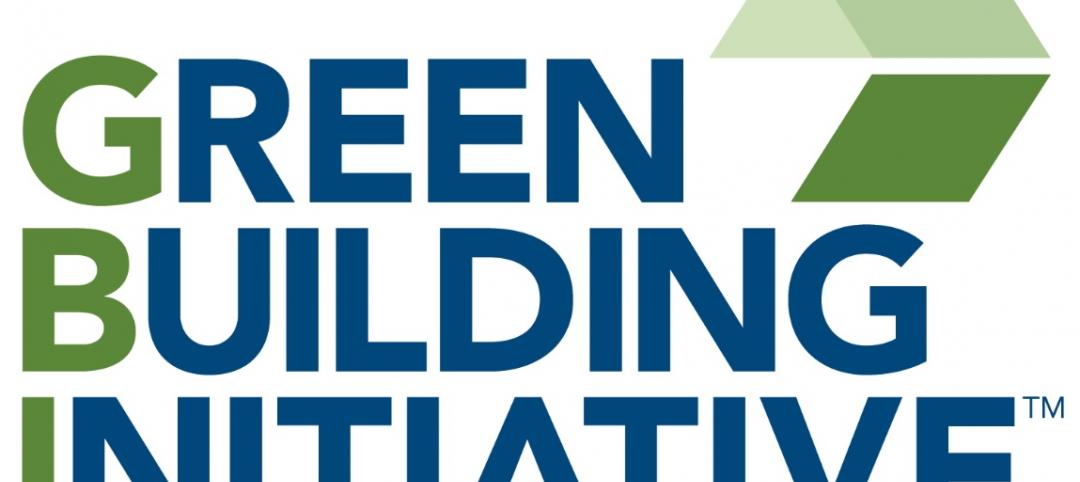More than 11% of the world’s electricity is produced by 447 commercial nuclear power reactors operating in 31 countries. The U.S. alone generates just under one-fifth of its electricity—19.7%—from 99 nuclear reactors operating in 30 states that produce 805.3 billion kilowatt-hours of power. At the end of last year, there were 61 nuclear plants under construction worldwide, the equivalent of 16% of existing capacity, and another 160 that have been firmly planned.
These statistics, from the World Nuclear Association and the Nuclear Energy Institute, would suggest that nuclear power—despite ongoing issues related to safety, security, regulations, and radioactive waste storage—is an ascending alternative to fossil fuels as a source of low-carbon power in a world that is increasing concerned about the impact of climate change.
In an opinion piece that Forbes published in early September, nuclear advocate and scientist James Conca noted that two nuclear power plants near Houston—which provide 2,700 MW of power to two million customers in the area—stayed fully operational during Hurricane Harvey, which caused oil refineries to shut down.
The next generation of nuclear plants will be smaller—the plants under construction range from 70 to 1,750 gross MWs—and resilient. But groups that promote nuclear as an essential ingredient of any cocktail of alternative energy sources “don’t have a large bank of imagery to draw upon” to show the public nuclear’s capabilities, says Suzanne Baker, a spokesperson for Third Way, a neoliberal think tank in Washington D.C.
Earlier this year, Third Way commissioned Gensler to come up with sketches and renderings that can be used to explain the role that advanced reactors could play in a variety of energy systems that enable the world to reach its goals for reducing CO2 emissions. Those renderings were exhibited at D.C.’s Fathom Gallery on Oct. 28. The images can be downloaded from Third Way’s website.
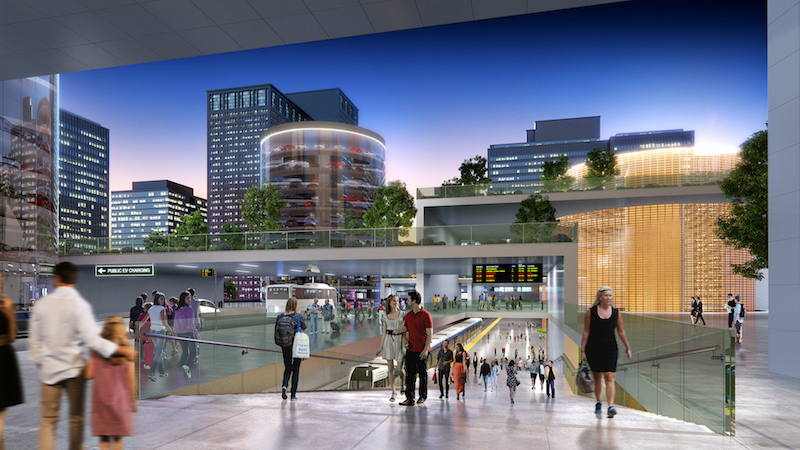
The rendering of a transit hub, where a nuclear reactor provides zero-emissions power for rail and electric vehicles. Image: Third Way
Gensler worked up images for six “scenarios” where nuclear could provide low-carbon power. These include
•A remote arctic community, off the power grid, where electricity is extremely pricey;
•A clean transit hub, where a small reactor powers rail lines, personal electric vehicles, shared autonomous vehicles, and electric buses;
•Growing communities in the developing world where large-scale reactors provide power, and whose excess capacity is used for an onsite desalination plant to provide clean water;
•A high-temperature reactor to power and heat for local industries;
•A Naval base, where advanced reactors generate around the clock electricity and power ships docked at port; and
•Powering data centers, upon which many of life’s daily functions are increasingly dependent.
While much of the growth in nuclear energy technology is occurring overseas, specifically in Russia, China, and the United Arab Emirates, Third Way believes the renderings can help spur innovation in the U.S.—which in recent years has all but ceased building nuclear plants in favor of other forms of alternative energies—“and help American nuclear companies and technologies become more competitive in international energy markets,” says Baker.
She acknowledges that Gensler’s portfolio does not include a broad range of nuclear power plant designs. But, she explains, “We wanted a fresh eye on the topic.” Baker adds that Gensler’s designs typically emphasize sustainability, so the commission “was an alignment of values.”
Earlier this year Baker “cold called” Gensler’s D.C. office about its interest in this project. “Our receptionist went over the public address system and said 'would someone from the Green Team dial zero?,' ” recalls Liz Resenic, LEED AP BD+C, WELL AP, a sustainability specialist at Gensler.
The firm doesn’t have a “green team,” per se; Resenic, on its sustainability team, took the called and spoke with Baker for about 15 minutes about visualization.
At that point, Gensler’s most notable experience in the nuclear power arena was its master planning and urban design for its K.A. CARE project, which stands for the King Abdullah City for Atomic and Renewable Energy in Riyadh, Saudi Arabia.
The firm agreed to accept Third Way’s commission “because we’re interested in being part of this conversation,” says Duncan Lyons, RIBA, LEED AP BD+C, a Senior Associate and Office Building Developers Practice Area Leader, who was the lead designer on this project. (Other Gensler associates who worked on the renderings and sketches include Gregory Plavcan, Matthew Boland, and Katie Costa.)
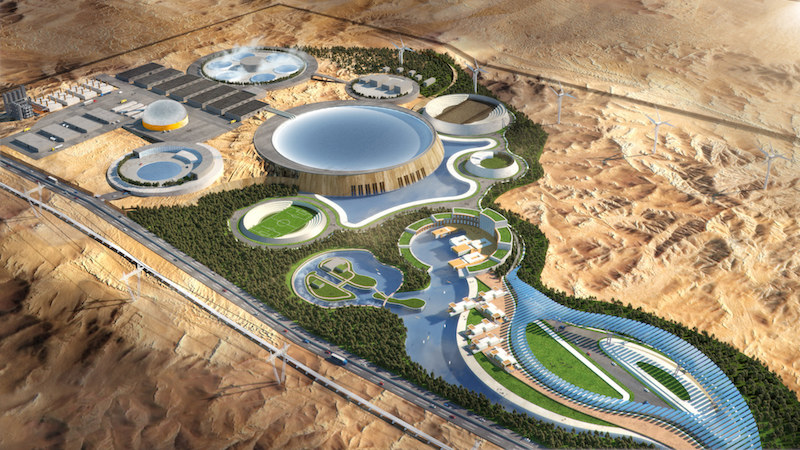
A desert compound whose advanced nuclear reactor pumps out 1,000-plus MW of capacity that supplies a nearby growing city. Image: Third Way
The project operated under a tight schedule: Visualizing sessions were conducted in August, for which Gensler pulled images from the nuclear industry as well as related examples of energy produced by hydro, solar and wind, says Lyons.
Gensler started producing the renderings and sketches in September, and completed them last month.
Baker says Third Way is targeting three audiences with its renderings: policy makers, the press, and the nuclear sector itself, which could use the illustrations in debates about the efficacy of nuclear power.
Related Stories
| Jan 16, 2014
The incandescent light bulb is not dead
Despite misleading media reports, January 1 did not mark a ban on the manufacture or import of 60-watt and 40-watt incandescent bulbs.
| Jan 11, 2014
Getting to net-zero energy with brick masonry construction [AIA course]
When targeting net-zero energy performance, AEC professionals are advised to tackle energy demand first. This AIA course covers brick masonry's role in reducing energy consumption in buildings.
| Jan 6, 2014
Green Building Initiative names Jerry Yudelson as new President
The Green Building Initiative announced today that it has named Jerry Yudelson as its president to accelerate growth of the non-profit and further leverage its green building assessment tools, including the highly recognized Green Globes rating system.
| Jan 6, 2014
An interview with Jerry Yudelson, President, The Green Building Initiative
Green building consultant Jerry Yudelson has been named President of the Green Building Initiative and the Green Globes rating program. BD+C's Robert Cassidy talks with Yudelson about his appointment and the future of Green Globes.
| Jan 2, 2014
Measuring whole building energy use among big changes in LEED v4
A new prerequisite in LEED v4 calls for each project to measure whole building energy use, and then share that data with USGBC.
| Dec 31, 2013
Top 10 blog posts from 2013
BD+C editors and our contributors posted hundreds of blogs in 2013. Here's a recap of the most popular topics. They include valuable lessons from one of the first BIM-related lawsuits and sage advice from AEC legend Arthur Gensler.
| Dec 20, 2013
Can energy hogs still be considered efficient buildings? Yes, say engineers at Buro Happold
A new tool from the engineering firm Buro Happold takes into account both energy and economic performance of buildings for a true measure of efficiency.
| Dec 17, 2013
Nation's largest net-zero K-12 school among winners of 2013 Best of Green Schools award
The Lady Bird Johnson Middle School in Irving, Texas, was named a winner of USGBC's annual award, along with nine other schools, individuals and communities working toward the common goal of healthy, high-performing learning places.
| Dec 10, 2013
16 great solutions for architects, engineers, and contractors
From a crowd-funded smart shovel to a why-didn’t-someone-do-this-sooner scheme for managing traffic in public restrooms, these ideas are noteworthy for creative problem-solving. Here are some of the most intriguing innovations the BD+C community has brought to our attention this year.
| Nov 27, 2013
LEED for Healthcare offers new paths to green
LEED for Healthcare debuted in spring 2011, and certifications are now beginning to roll in. They include the new Puyallup (Wash.) Medical Center and the W.H. and Elaine McCarty South Tower at Dell Children’s Medical Center of Central Texas in Austin.


